

4-Week Body Recomposition Plan
Lose Fat While Gaining Muscle
The Art of Recomp: Can You Really Burn Fat and Build Muscle?
Most fitness plans make you choose: bulk or cut. But what if you could do both—at the same time? That’s where body recomposition comes in. Recomp is the science-backed strategy of losing fat while building lean muscle, and while it’s not easy, it’s absolutely possible—especially for intermediate lifters with a few months (or years) of training experience under their belt.
This 4-week body recomposition workout plan is designed to break plateaus, reshape your physique, and renew your motivation by combining progressive overload training, hypertrophy-based lifting, and strategic cardio. You’ll also get nutrition tips tailored to support both muscle growth and fat loss.
Whether you're returning from a break, stuck at the same bodyweight, or trying to sharpen your body ahead of summer, this plan helps you unlock visible results in just 4 weeks—without crash dieting or endless cardio.
What Is Body Recomposition?
Body recomposition refers to the process of simultaneously reducing body fat and increasing muscle mass. Unlike bulking (which adds size at the expense of fat gain) or cutting (which trims fat but often sacrifices some muscle), recomposition targets a better fat-to-muscle ratio—changing your body shape without necessarily changing your weight dramatically.
Is It Possible for Everyone?
Yes—but your experience level matters:
Beginners can recomp with ease since nearly any training or nutrition improvement sparks results.
Intermediates (6+ months consistent lifting) benefit most from structured plans like this.
Advanced lifters may need to fine-tune hormones, periodization, and nutrition with more precision to see results.
Key Principles of a Body Recomposition Workout Plan
To successfully recomp your body, your training program must walk a tightrope: provide enough stimulus to build and preserve lean muscle while creating just enough energy demand to promote fat loss. It’s a balancing act, and the key is to align three foundational principles in your training:
1. Progressive Overload (Strength Focus)
If you’re not gradually getting stronger, your body has no reason to hold on to muscle—especially in a calorie-controlled state. Progressive overload is the method of consistently increasing the demand on your muscles through heavier loads, more reps, better form, or higher training density.
For recomp, your goal isn’t to max out every week or chase PRs blindly. Instead, focus on steady, measurable progress over time. Track your lifts and aim to:
Add weight to the bar every 1–2 weeks
Increase reps at a given weight
Improve tempo or range of motion
Why it matters: Strength-focused training activates fast-twitch muscle fibers and sends a strong anabolic signal to your body. Even in a slight calorie deficit, this encourages your body to retain muscle mass—especially if you’re eating sufficient protein and recovering well.
2. Hypertrophy Training (Muscle Building)
While strength training drives neurological adaptation and total muscle recruitment, hypertrophy training (8–12 reps, 3–4 sets, moderate rest) builds volume and muscle size through mechanical tension and metabolic stress.
Key factors for hypertrophy during recomposition:
Time Under Tension: Controlled eccentric movements (2–3 seconds) increase muscular workload without requiring heavier weights.
Mind-Muscle Connection: Focus on feeling the target muscle work rather than just moving weight.
Training Volume: Total weekly sets per muscle group matter—aim for 10–20 per week depending on recovery and training split.
Why it matters: Muscle growth is slower in a deficit or maintenance phase, but possible—especially for intermediates. Prioritizing hypertrophy ensures you're not just holding onto muscle, but potentially building it where you previously under-trained.
3. Strategic Cardio (Fat Burning)
Cardio during recomp should serve two roles:
Create a small additional calorie deficit without needing to slash food
Improve cardiovascular fitness to support training and recovery
But too much cardio can backfire, increasing fatigue and interfering with strength gains. The solution? Be strategic.
2–3 low-intensity sessions per week (20–30 minutes of walking, cycling, incline treadmill)
1 optional HIIT session (e.g., 30s sprint + 90s rest x 5–7 rounds) if energy levels are high and recovery is solid
Zone 2 cardio (around 60–70% of max heart rate) is ideal during recomp—it supports fat oxidation and helps manage recovery without tapping into muscle tissue for fuel.
Why it matters: Recomp isn’t a cutting phase. You want to keep recovery high and performance strong. Cardio should complement training, not compete with it.
Customizing Your Recomp: Training Age, Body Type & Goal Priority
While the core principles of strength, hypertrophy, and strategic cardio apply to everyone, your training background, body type, and recomp goal (fat loss vs. muscle gain) should influence how you apply them.
1. Training History (Beginner, Intermediate, Advanced)
🟢 Beginners (0–6 months of consistent lifting)
Strategy: Recomp comes easy here. Almost any structured program with adequate protein and moderate calories will lead to fat loss and muscle gain.
Tips:
Focus on learning movement patterns and building consistency.
Keep weights light-to-moderate while mastering form.
Recovery is faster; you may improve quickly without needing advanced methods.
🟡 Intermediates (6–24 months consistent training)
Strategy: This plan is ideal for intermediates—your body is primed to respond to progressive overload and volume, but it also requires more precision.
Tips:
Track lifts weekly and ensure progressive overload.
Slight calorie deficit (10–15%) helps nudge fat loss without stalling gains.
Sleep and recovery become more important.
🔴 Advanced Lifters (2+ years of serious training)
Strategy: Recomp becomes slower and more nuanced here. Gains are harder to come by unless calories and stimulus are dialed in.
Tips:
Consider periodizing your recomp: 6–8 weeks recomp, 2–3 weeks reverse dieting or maintenance.
Use more advanced training techniques (drop sets, pause reps, cluster sets).
Monitor recovery markers like sleep, HRV, and motivation.
2. Body Type & Genetics (Ectomorph, Mesomorph, Endomorph)
While not a hard science, your natural build can influence how you respond to recomp strategies:
Ectomorph (naturally lean, struggles to gain mass)
Prioritize: Muscle gain over fat loss
Strategy: Eat at maintenance or slight surplus; keep cardio minimal
Tip: Use hypertrophy-style volume with moderate weights, focus on compound lifts, and avoid under-eating
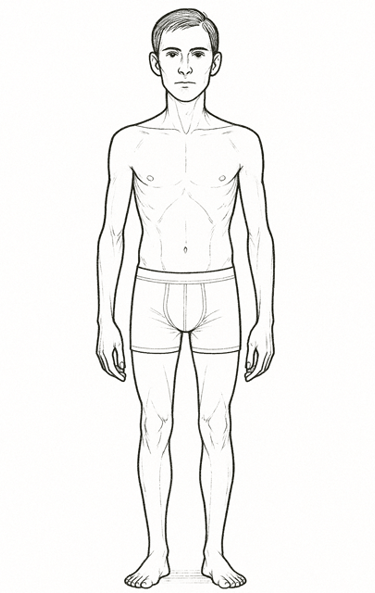

Mesomorph (naturally muscular, gains/loses easily)
Balanced recomp works best
Strategy: Moderate deficit or maintenance intake; push hard on training
Tip: These individuals often thrive on full-body or upper/lower splits with structured progression


Endomorph (stores fat easily, gains strength quickly)
Prioritize: Fat loss while preserving lean mass
Strategy: Use slight-to-moderate deficit, maintain high protein, and include steady-state cardio
Tip: Recovery can be slower—watch training frequency and volume
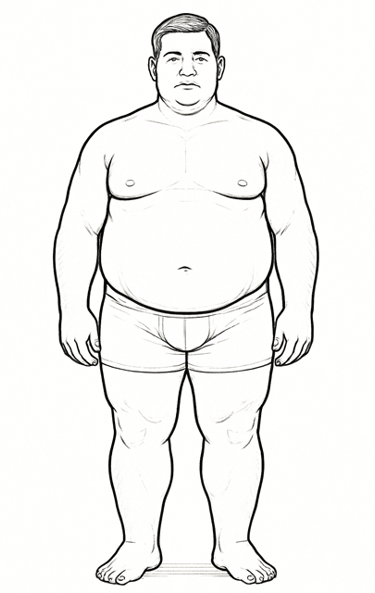

Note: Few individuals fit perfectly into a single somatotype. These categories—ectomorph, mesomorph, and endomorph—are broad classifications based on observable traits and tendencies, not strict physiological rules.
Use them as reference points, and prioritize the strategy that aligns closest with your current physique and how your body typically responds to training and nutrition.
3. Goal Priority: Fat Loss–Dominant vs. Muscle Gain–Dominant Recomp
Recomposition always aims to do both (lose fat and gain muscle), but you can tilt the plan slightly depending on what matters most to you right now:
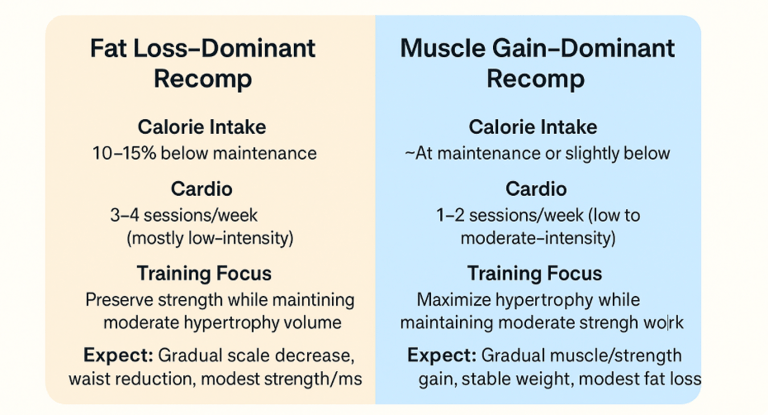

Summary Table: Tailoring Your Recomp Plan
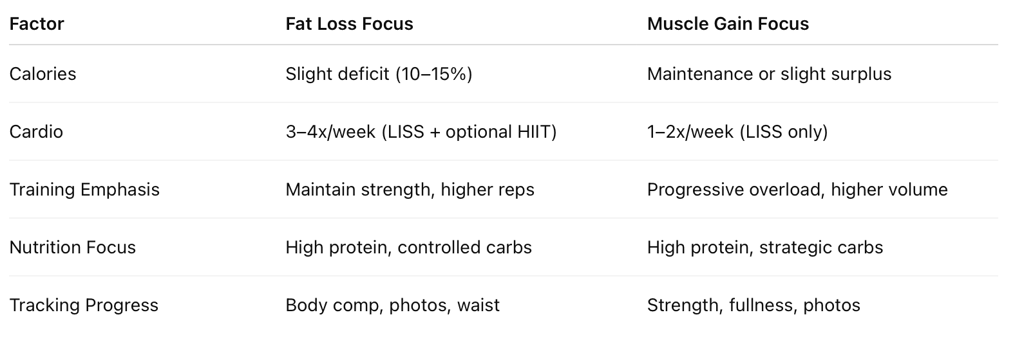

Your 4-Week Recomposition Training Plan
This plan is built to help intermediate lifters shift body composition—not just burn calories, but retain (or even build) muscle while shedding fat. The weekly structure uses a classic upper/lower split with strength-focused and hypertrophy-focused days. It includes strategic cardio and built-in recovery to keep your performance high and fatigue low.
The goal is simple: train hard, recover well, and stimulate both muscle growth and fat loss—without overtraining.
Weekly Structure
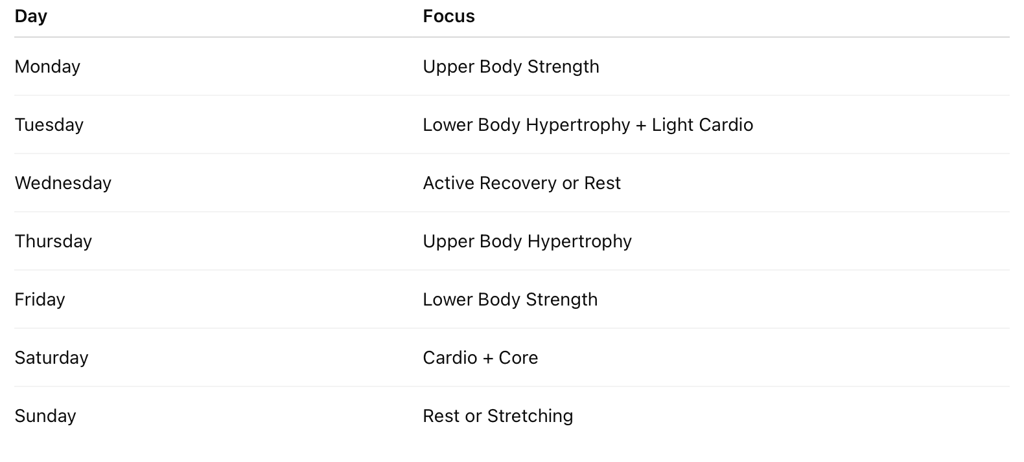

This structure offers:
Strength early in the week when you're freshest
Hypertrophy work mid-week for muscular volume and shaping
Cardio + core on Saturday to support fat loss and conditioning
Two dedicated recovery slots (Wednesday and Sunday) to manage fatigue, support muscle repair, and help you train harder on key days
Each workout is designed to take 60–75 minutes, including warm-up and cooldown. Stick to it consistently for 4 weeks, and you’ll be surprised how much your body can shift—without a crash diet or endless cardio.
Week-by-Week Training Overview
Week 1–2: Foundation and Volume
Upper Strength (Monday)
Barbell Bench Press – 4x5
Pull-Ups (Weighted if possible) – 4x6
Overhead Press – 3x6
Barbell Rows – 3x8
Plank – 3x45 sec
Lower Hypertrophy (Tuesday)
Bulgarian Split Squats – 3x10
Romanian Deadlifts – 3x10
Leg Press – 3x12
Calf Raises – 3x15
20-minute incline walk (light cardio)
Upper Hypertrophy (Thursday)
Incline Dumbbell Press – 3x10
Lat Pulldown – 3x10
Lateral Raise – 3x12
Seated Row – 3x10
Cable Curls + Triceps Pushdown Superset – 3x12 each
Lower Strength (Friday)
Barbell Back Squats – 4x5
Romanian Deadlift – 3x6
Walking Lunges – 3x10 each leg
Hanging Knee Raises – 3x12
Saturday Core + Cardio
30 minutes Zone 2 cardio (e.g. incline walk, cycling)
Core Circuit: Leg Raises, Russian Twists, Deadbugs – 3 rounds
Week 3–4: Intensity and Refinement
Focus on progressing weights and cleaning up form. You can introduce tempo (3-second eccentrics) or pause reps for added muscle tension.
Upper/lower splits remain the same.
Increase intensity by:
Reducing rest (60–90s on hypertrophy days)
Adding 5–10% load if technique remains sharp
Slightly increasing cardio duration or incline for metabolic adaptation
Nutrition Guidelines for Recomposition
Eat at (or Just Below) Maintenance
Use the TDEE+ calculator to find your maintenance calories. From there:
Option 1 (Cautious Cut): 10–15% deficit (~250–350 kcal below maintenance)
Option 2 (Lean Gain): Eat at maintenance and optimize nutrient timing
Protein is Non-Negotiable
Goal: 0.8–1g protein per lb of bodyweight (1.8–2.2g/kg)
Spread intake across 4–5 meals
Prioritize lean sources: chicken, eggs, protein shakes, Greek yogurt
Don’t Fear Carbs
Carbs fuel training and muscle growth:
Focus on whole-food sources: oats, rice, fruits, potatoes
Time higher carbs around workouts
Hydration + Sleep
7–9 hours of sleep
2–3 liters of water/day
Manage stress to optimize recovery and hormonal balance
Common Recomposition Mistakes to Avoid
Cutting calories too hard – This can trigger muscle loss
Too much cardio – More isn’t better; recovery suffers
Changing workouts every week – Stick to the plan to gauge real progress
Ignoring sleep – Your body grows and recovers at rest, not in the gym
Progress Tracking: What to Look For
Scale weight may stay the same. Instead, focus on:
Waist circumference going down
Strength and rep increases
Visual muscle definition
Biofeedback: energy, sleep, mood, hunger
Tip: Take photos weekly in consistent lighting. It’s one of the best ways to see recomp progress.
Can You Repeat This Plan?
Absolutely. In fact, one of the biggest mistakes people make with body recomposition is program-hopping too soon. Four weeks is just the start—your body needs consistency, progressive challenge, and strategic tweaks over time to keep adapting.
Here’s how to transition smoothly into a second 4-week cycle while making it even more effective:
Reassess and Adjust Your Weights
After four weeks, go back through your training log and ask:
Am I lifting more than I was in Week 1?
Has my technique improved under heavier loads?
Are my reps smoother or more controlled?
If you’ve hit most of your lifts with good form, increase the working weight by 5–10% on your main lifts. This small progression keeps the stimulus high enough for further strength and muscle growth—without overwhelming your recovery system.
Slightly Modify Cardio if Needed
If your fat loss has plateaued, don't panic or slash calories too aggressively. Instead:
Add 5–10 minutes to your cardio sessions
Slightly increase incline or intensity on steady-state cardio
Optionally introduce one more cardio day (especially Zone 2)
These changes help nudge fat loss forward while still protecting muscle mass.
Introduce Advanced Techniques
Once you’ve built a base and your body has adapted to the volume and structure, you can layer in advanced training techniques to promote further muscle development and training intensity. Examples include:
Drop Sets: Perform a set to failure, then immediately reduce the weight and keep going (great for isolation moves).
Supersets: Pair two exercises back-to-back with minimal rest (e.g., biceps + triceps).
Tempo Training: Slow down the eccentric (lowering) portion of a lift to increase time under tension.
Pause Reps: Add a brief hold at the hardest point (e.g., bottom of a squat or bench press) to increase control and activation.
Only add one or two of these techniques at a time—your goal is to build, not burn out.
Optional: Shift Focus Slightly
Depending on your results and goals, you can also shift the emphasis of your next cycle:
Want to lean out more? Slightly reduce calories and increase light cardio.
Want to build more size? Increase total volume and ensure you're eating at maintenance or just above.
Want better conditioning? Try replacing one hypertrophy day with a metabolic circuit or sled push session.
Recomp is a longer game—it’s not about quick fixes, but strategic consistency. By repeating this 4-week plan with smart adjustments, you’ll continue to lose fat and gain muscle with far less frustration than switching plans every month.
When to Quit Recomp: Knowing When to Switch Gears
While body recomposition can be a powerful tool, it’s not meant to last forever. At a certain point, the same strategy that once delivered visible changes can become a plateau. That’s when it’s time to stop, reassess, and move into a new phase—typically reverse dieting or structured maintenance.
Here’s how to know it’s time to end your recomp phase:
1. You’ve Been Recomping for 8–12 Weeks Already
Much like a fat loss phase, recomping requires a balance of slight energy restriction, high training demand, and tight recovery management. This creates stress. And like any fat-loss effort, it’s best capped at 9–12 weeks before your body adapts, progress slows, or recovery begins to suffer.
If you've followed the plan diligently for 9+ weeks, that’s a natural point to shift to reverse dieting—even if your end goal isn’t fully reached yet.
2. You're No Longer Seeing Measurable Progress
Recomp can feel slow—weight might not change much, but you should still notice:
Waist shrinking
Visual changes in the mirror or photos
Strength gains in key lifts
Improved muscle definition
If none of those things have budged in 3–4 weeks, despite consistent training, sleep, and nutrition, you're likely under-recovered or metabolically adapted—time to transition.
3. Your Performance or Recovery Is Declining
Signs you’ve been in a deficit too long or your body needs a break:
Sluggish workouts, poor pumps
Mood swings or sleep disruption
Constant soreness or nagging injuries
Loss of strength or stalled lifts
These are classic markers that you’ve squeezed all you can out of your current phase and should move into a recovery-focused reverse diet or short maintenance block.
What to Do Next: Reverse Diet or Maintenance Phase
After recomp, it’s critical to increase calories gradually and reduce overall training stress to:
Restore full recovery
Reignite metabolic flexibility
Prepare for the next performance or physique phase
Most people benefit from:
1 or 2 weeks of reverse dieting (by slowly increasing your intake by about 100 kcal every 3 to 4 days)
Continuing to train with intensity but reducing cardio
Reassessing goals at a higher calorie baseline
Bottom Line
Don’t stay in recomp mode indefinitely.
The same strategy that works at first will eventually stop working if you don’t periodize. Aim for 8–12 weeks, then move into a structured reverse diet phase or maintenance break to keep your results sustainable—and set up your next success.
Final Thoughts: Is Recomp Right for You?
This 4-week body recomposition workout plan isn’t magic—it’s a targeted method that blends smart training and nutrition to change your body composition. If you're an intermediate lifter who's stuck between bulking and cutting, this is the middle ground you’ve been looking for.
It takes patience, discipline, and consistency—but the results are worth it. You don’t have to choose between being lean or strong. You can be both.
References
1. Schoenfeld, B.J., Ogborn, D., & Krieger, J.W. (2016).
Title: Effects of Resistance Training Frequency on Measures of Muscle Hypertrophy: A Systematic Review and Meta-Analysis
Journal: Sports Medicine, 46(11), 1689–1697
Summary: This meta-analysis shows that training each muscle group more than once per week leads to significantly greater hypertrophy, which supports the use of an upper/lower split in recomposition programs.
URL: https://pubmed.ncbi.nlm.nih.gov/27102172/
2. Helms, E.R., Aragon, A.A., & Fitschen, P.J. (2014).
Title: Evidence-Based Recommendations for Natural Bodybuilding Contest Preparation: Nutrition and Supplementation
Journal: Journal of the International Society of Sports Nutrition, 11(1), 20
Summary: Suggests maintaining a modest caloric deficit and high protein intake to preserve muscle while reducing fat—key principles in body recomposition.
URL: https://jissn.biomedcentral.com/articles/10.1186/1550-2783-11-20
3. Phillips, S.M., & Van Loon, L.J.C. (2011).
Title: Dietary Protein for Athletes: From Requirements to Optimum Adaptation
Journal: Journal of Sports Sciences, 29(sup1), S29–S38
Summary: Recommends 1.3–1.8 g/kg protein intake for strength athletes, evenly distributed throughout the day, to optimize muscle protein synthesis and recovery.
URL: https://www.tandfonline.com/doi/full/10.1080/02640414.2011.619204
4. Wilson, J.M., Marin, P.J., Rhea, M.R., et al. (2012).
Title: Concurrent Training: A Meta-Analysis Examining Interference of Aerobic and Resistance Exercises
Journal: Journal of Strength and Conditioning Research, 26(8), 2293–2307
Summary: Confirms that high volumes of cardio can interfere with strength and muscle gains, validating the importance of limiting cardio in recomp strategies.
URL: https://pubmed.ncbi.nlm.nih.gov/22002517/
5. Hackett, D.A., Johnson, N.A., & Chow, C.M. (2013).
Title: Training Practices and Ergogenic Aids Used by Male Bodybuilders
Journal: Journal of Strength and Conditioning Research, 27(6), 1609–1617
Summary: Documents typical hypertrophy-focused training styles used by competitive bodybuilders, reinforcing rep ranges and volume recommendations in the plan.
URL: https://pubmed.ncbi.nlm.nih.gov/22990567/
6. Trexler, E.T., Smith-Ryan, A.E., & Norton, L.E. (2014).
Title: Metabolic Adaptation to Weight Loss: Implications for the Athlete
Journal: Journal of the International Society of Sports Nutrition, 11(1), 7
Summary: Reviews how aggressive dieting slows metabolism and reduces lean mass, supporting the article’s emphasis on slow, strategic fat loss.
URL: https://jissn.biomedcentral.com/articles/10.1186/1550-2783-11-7
7. Damas, F., Phillips, S.M., Libardi, C.A., et al. (2016).
Title: Resistance Training-Induced Changes in Integrated Myofibrillar Protein Synthesis Are Related to Hypertrophy Only After Attenuation of Muscle Damage
Journal: Journal of Physiology, 594(18), 5209–5222
Summary: Demonstrates that consistent resistance training drives hypertrophy through accumulated protein synthesis, especially once initial muscle damage subsides.
URL: https://pubmed.ncbi.nlm.nih.gov/27219125/
